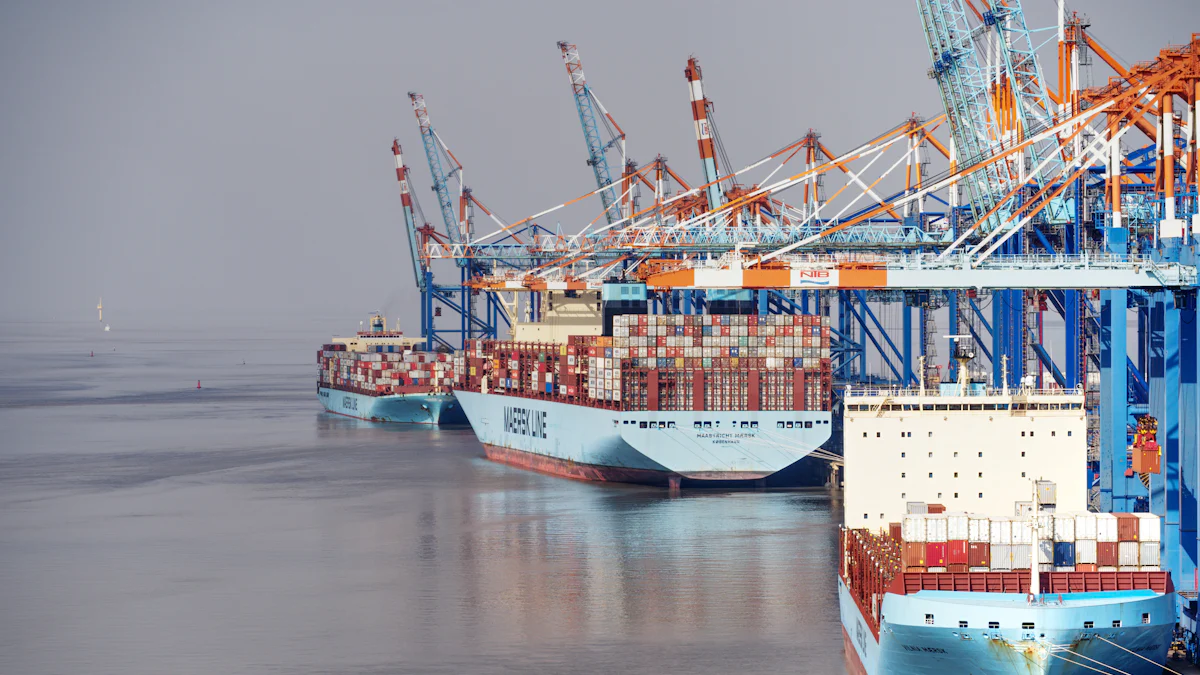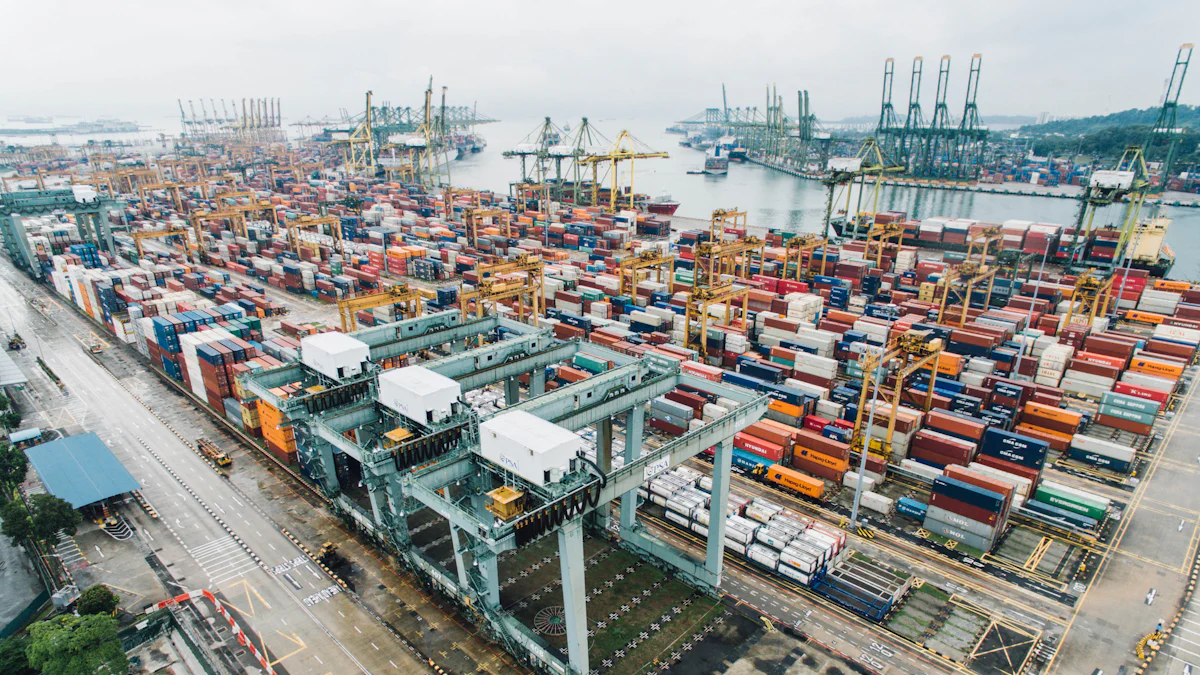Emerging trends and challenges in cross-border e-commerce logistics

Cross-border e-commerce logistics plays a crucial role in the global market. The logistics sector is expected to grow by USD 80.1 billion at a CAGR of 13.29% between 2023 and 2028. This growth highlights the need for efficient logistics solutions. Companies must understand emerging trends and challenges to succeed. JUSDA Supply Chain Management International Co., Ltd. leads the industry with innovative technologies like AI and blockchain. These advancements drive growth and efficiency. JUSDA's comprehensive services ensure seamless operations from factory to consumer.
Current Trends in Cross-Border E-Commerce Logistics

Technological Advancements
Automation and AI
Automation and AI have transformed cross-border e-commerce logistics. These technologies enhance efficiency and reduce costs. AI-integrated systems handle more data than humans, leading to better decision-making. Companies use AI to optimize routes and manage inventory. This results in faster deliveries and improved customer satisfaction. AI fosters collaboration among companies, improving sustainability within supply chain networks. However, AI-driven decisions may lack interpretability, which can lead to ambiguity.
Blockchain Technology
Blockchain technology plays a crucial role in cross-border e-commerce logistics. This technology improves the security and accuracy of data. Blockchain ensures traceability in supply chains, which enhances transparency. Companies use blockchain to verify transactions and track shipments. This reduces fraud and errors in logistics processes. The integration of blockchain promotes market growth by offering versatile data management solutions.
Sustainability Initiatives
Eco-friendly Packaging
Eco-friendly packaging has become essential in cross-border e-commerce logistics. Companies focus on reducing waste and using sustainable materials. This approach minimizes environmental impact and meets consumer demands. Businesses adopt biodegradable and recyclable packaging options. These initiatives contribute to a greener supply chain. Sustainable packaging practices align with global environmental goals.
Green Transportation Solutions
Green transportation solutions are gaining traction in cross-border e-commerce logistics. Companies invest in fuel-efficient vehicles and alternative energy sources. This reduces carbon emissions and operational costs. Businesses explore electric and hybrid vehicles for deliveries. Green transportation aligns with sustainability goals and regulatory requirements. These solutions enhance the overall environmental performance of logistics operations.
Consumer Expectations
Faster Delivery Times
Consumers expect faster delivery times in cross-border e-commerce logistics. Companies strive to meet these expectations through efficient logistics networks. Businesses optimize supply chains to reduce transit times. Advanced technologies like AI and automation play a significant role. These efforts result in quicker deliveries and higher customer satisfaction. Meeting delivery expectations is crucial for maintaining competitiveness.
Personalized Shipping Options
Personalized shipping options have become a priority in cross-border e-commerce logistics. Consumers demand flexibility in delivery choices. Companies offer various shipping methods to cater to individual preferences. Businesses provide options such as same-day delivery and scheduled deliveries. Personalized shipping enhances the customer experience and builds brand loyalty. Offering tailored solutions is vital for success in the competitive e-commerce landscape.
Challenges in Cross-Border E-Commerce Logistics

Regulatory and Compliance Issues
Customs Regulations
Customs regulations present significant challenges in cross-border e-commerce logistics. Companies must prepare accurate documentation for smooth customs clearance. Incorrect documentation leads to delays and increased costs. Businesses should use correct HS codes to classify goods properly. Customs brokers can assist in navigating complex regulations. Trade agreements offer opportunities to reduce tariffs and facilitate smoother trade. Prioritizing compliance ensures efficient operations and enhances competitiveness.
Tariffs and Taxes
Tariffs and taxes impact the cost structure of cross-border e-commerce logistics. Companies face varying tariff rates based on the destination country. Understanding these rates is essential for accurate pricing strategies. Taxes also vary, affecting the final cost to consumers. Businesses must account for these financial obligations in their logistics planning. Effective management of tariffs and taxes reduces unexpected expenses and maintains profitability.
Supply Chain Disruptions
Global Events Impact
Global events significantly disrupt cross-border e-commerce logistics. Natural disasters, political instability, and pandemics affect supply chain operations. These events cause delays and increase shipping costs. Companies need contingency plans to mitigate such disruptions. Diversifying suppliers helps maintain a steady flow of goods. Businesses must stay informed about global developments to adapt quickly.
Inventory Management
Inventory management poses challenges in cross-border e-commerce logistics. Companies must balance stock levels to meet consumer demand. Excess inventory increases storage costs, while shortages lead to missed sales opportunities. Advanced technologies like AI optimize inventory management. Real-time data analysis improves decision-making and reduces waste. Efficient inventory management enhances customer satisfaction and operational efficiency.
Cost Management
Shipping Costs
Shipping costs represent a major challenge in cross-border e-commerce logistics. Fuel prices, labor costs, and transportation fees contribute to high expenses. Companies must find ways to reduce these costs without compromising service quality. Innovations like drone deliveries and autonomous vehicles offer potential solutions. Streamlining shipping processes improves delivery times and reduces costs.
Currency Fluctuations
Currency fluctuations affect the financial stability of cross-border e-commerce logistics. Exchange rate variations impact the cost of goods and services. Companies must monitor currency trends to manage financial risks. Hedging strategies help protect against adverse currency movements. Accurate forecasting ensures better budgeting and financial planning.
Strategies to Overcome Challenges
Leveraging Technology
Data Analytics
Data analytics plays a pivotal role in cross-border e-commerce logistics. Companies utilize data analytics to gain insights into consumer behavior and market trends. This information helps businesses optimize their supply chain operations. Data analytics enables companies to predict demand and manage inventory efficiently. Businesses can also identify potential bottlenecks and streamline processes. The use of data analytics leads to cost savings and improved customer satisfaction.
Real-time Tracking
Real-time tracking enhances visibility in cross-border e-commerce logistics. Companies implement real-time tracking systems to monitor shipments throughout the supply chain. This technology provides accurate information about the location and status of goods. Real-time tracking allows businesses to respond promptly to any disruptions. Customers benefit from increased transparency and receive timely updates on their orders. Real-time tracking improves trust and reliability in logistics operations.
Building Resilient Supply Chains
Diversification of Suppliers
Diversification of suppliers strengthens cross-border e-commerce logistics. Companies reduce dependency on a single supplier by sourcing from multiple vendors. This strategy mitigates risks associated with supply chain disruptions. Diversification ensures a steady flow of goods even during unforeseen events. Businesses can negotiate better terms and prices with a diverse supplier base. A resilient supply chain enhances operational efficiency and competitiveness.
Risk Management Practices
Risk management practices are essential in cross-border e-commerce logistics. Companies identify potential risks and develop strategies to mitigate them. Risk management involves assessing factors such as geopolitical instability and natural disasters. Businesses implement contingency plans to ensure continuity of operations. Effective risk management minimizes disruptions and protects against financial losses. Companies that prioritize risk management maintain a competitive edge in the market.
Enhancing Customer Experience
Transparent Communication
Transparent communication is crucial in cross-border e-commerce logistics. Companies provide clear and accurate information to customers regarding their orders. Transparent communication builds trust and fosters positive relationships with consumers. Businesses use various channels to keep customers informed about delivery timelines. Providing transparency in logistics operations enhances customer satisfaction. Companies that prioritize communication enjoy higher levels of customer loyalty.
Flexible Return Policies
Flexible return policies improve the customer experience in cross-border e-commerce logistics. Companies offer hassle-free return options to accommodate consumer preferences. Flexible return policies increase consumer confidence in online purchases. Businesses that provide easy returns attract more customers and boost sales. A well-structured return policy reduces friction in the buying process. Companies that implement flexible returns gain a competitive advantage in the e-commerce landscape.
Case Studies:
Setting up a distribution & fulfillment center: A luxury brands retailer successfully supported growth by establishing a dedicated center. This approach optimized logistics operations and enhanced customer service.
Optimizing distribution for a German beer company: An interactive data model improved distribution efficiency. The company achieved better resource allocation and reduced costs.
Cross-border e-commerce logistics faces significant trends and challenges. Companies must adapt to technological advancements and sustainability initiatives. The logistics landscape requires continuous adaptation to remain competitive. Future prospects in this field appear promising with ongoing innovations. JUSDA remains committed to delivering excellence and innovation. The company prioritizes sustainable solutions and efficient operations. JUSDA leverages experience and advanced technologies to optimize supply chains. The focus on data-driven insights enhances performance and fosters growth. JUSDA's dedication ensures reliable and precise logistics solutions for global trade.
See Also
Revealing Supplier Dynamics: Cross-Border E-commerce Innovations
Analyzing the Effects: Trends in Logistics Risk
Maximizing Growth: Supply Chain Visibility in Global E-commerce
